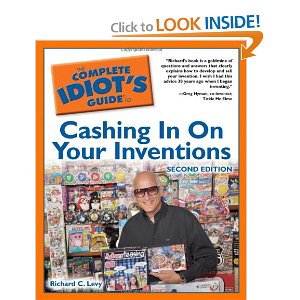Title: The Complete Idiot’s Guide to Cashing In On Your Inventions (2nd Edition)
Author: Richard C. Levy
Price: $12.31 (Amazon)
 In all honesty, and in the interests of full disclosure, I have to confess that something has always rubbed me the wrong way about the “Complete Idiot’s Guide” series, that, much like the rival “For Dummies” seemingly endless series of books seems to put down its intended audience by its very titles. I’m no “complete idiot” or “dummy,” even if there are things I need to become more informed about, and these titles always seemed to imply some lack of innate intelligence, rather than merely an ignorance of a particular subject matter.
In all honesty, and in the interests of full disclosure, I have to confess that something has always rubbed me the wrong way about the “Complete Idiot’s Guide” series, that, much like the rival “For Dummies” seemingly endless series of books seems to put down its intended audience by its very titles. I’m no “complete idiot” or “dummy,” even if there are things I need to become more informed about, and these titles always seemed to imply some lack of innate intelligence, rather than merely an ignorance of a particular subject matter.
That being said, I’ll have to admit, after perusing this book, that it does take care of business and explains what the novice inventor needs to know in a readable and understandable manner.
If you’ve read any book in this series, you know about the lively and graphically entertaining format, and the way i n which things are carved up into bit size chunks, with lots of little useful details that would otherwise take endless hours to compile. The book is divided into 23 chapters and each chapter into very subject specific subsections. It concludes with a glossary, agreement templates, and a listing of resources.
The chapters on patents and other intellectual property subjects are far more detailed than in many similar books, and cover conducting patent searches for prior art, applying for utility patents, plant patents, design patents, branding a product or line of products, trademarks and trade secrets, copyrights and the patent examination process at the federal level. There may be portions of some of this you may want to skim if it is not immediately applicable to your situation, but the book makes a handy reference work for later reading on such subjects when needed.
The author, Richard C. Levy, is a noted innovator in the realm of toys and games, and is the creator of the popular Furby toy and such games as “Chicken Soup for the Soul,” “Advertising,” and “Men Are From Mars, Women Are From Venus.” It is no surprise then to find that he has a lot of practical advice to offer about the devising of toys and games, while not limiting the book’s horizons to that narrow a class of products. He goes into fairly elaborate detail about the importance of creating models, mock-ups and prototypes.
The discussion on how to find a licensing partner and how to present and promote your concept are also very useful and leave little to the imagination, including the use of presentation software like PowerPoint and the use of Skype or similar video conferencing software to make presentations and answers questions from a distance when it is not possible or practical to be there in person.
The chapter on “Negotiating You Deal” is excellent, and includes the whimsical “Levy’s 10 Commandments of Contract Negotiation,” some of which the author admits to having paid a price to learn. The financial nitty-gritty of advances, royalties, guarantees and options are all addressed as is the issue of who pays for the process of obtaining patents and trademarks and in whose name they are held.
In the end, I have to acknowledge that this is a well-written, information packaged, and beneficial book for inventors.
I just still wish they would call it something like “The Intelligent Person’s Guide to Cashing In On Your Inventions!”
